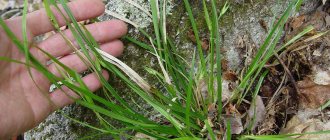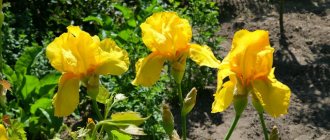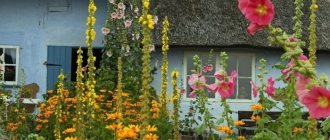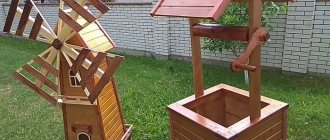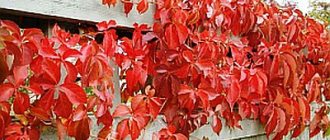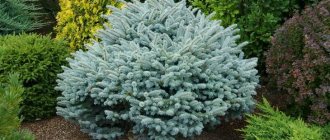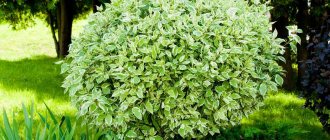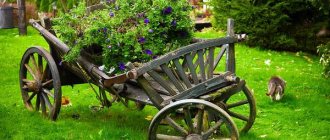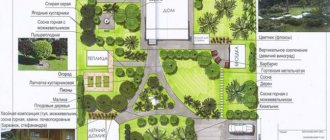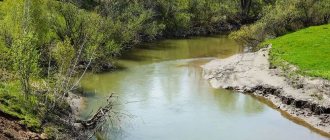Most gardeners and lawn owners believe that sedge is a weed and it is quite difficult to remove it from the site. Other flower growers and landscape designers are happy to grow various decorative varieties of this plant in mixborders, flowerpots and flower beds. Let's figure out what kind of perennial sedge is, what types and varieties it comes in.
Decorative sedge - botanical information
Ornamental sedge for the garden is a perennial herbaceous plant from the sedge family, growing in all corners of the world. According to various sources, there are from 1500 to 2000 species of sedge.
Main features of the plant:
- The root system is fibrous, can be elongated or shortened, but always with adventitious roots.
- The leaf blades are narrow and sharp, arranged in three rows.
- During the flowering period, the plant is covered with flowers, which are divided into dioecious and monoecious, collected in spikelets. They have a drooping shape and hang from the stems.
When planting and caring for decorative sedge, you need to take into account that all plant varieties differ in appearance and growing requirements. They may appear as lush grass, small shrubs, or a thick “carpet” covering the ground.
Growing sedge
There is no care for the plant as such; it is from the wild and is adapted to take care of itself on its own. The only thing when planting a flowerbed in order to preserve the beauty, lushness and greenery of a plant is to take into account its characteristics.
Some species can burn under the active sun, so it is better to plant them in at least partial shade. And those species that love moisture should not be overdried. You especially need to pay attention to these nuances in the summer.
Popular varieties of decorative sedge
In landscape design, decorative sedge is used due to the huge variety in size, shape and shades of the bush, variations in inflorescences and other characteristics. In botany, all varieties of sedge are divided into two large groups - tall and short. But only a few of them have found application in the field of landscape gardening.
Popular varieties of decorative sedge:
- Rusty-spotted sedge is a low plant, 20-40 cm, that forms beautiful and compact clumps of lush leaves. The shoots of the plant have a reddish tint, and by the end of the season they are covered with brownish-rusty spots. It blooms in early spring, the inflorescences look like small spikelets.
- Phoenix sedge is a medium-sized plant, the height of which does not exceed 45-60 cm. Phoenix attracts attention with its lush, eye-catching greenery, due to which it is often used for landscaping retaining walls and creating original compositions.
- Palmolia sedge - this variety, originally from North America, received its name due to its original appearance. The plant resembles an exotic palm tree, as can be seen in the photo of palmate sedge. It has narrow and long leaf blades located on an erect stem in opposite order. Bush of medium height, up to 50-70 cm.
- Golden sedge is a variety native to North America, with erect stems up to 35-45 cm high. After flowering, fruits are round in shape and bright orange or golden in color.
- Sedge Mists of the Amazon is one of the most popular and widespread varieties of ornamental crops. Lush perennial bushes have a height of no more than 25-35 cm. The plant is distinguished by an unusual twisted shape of leaves, a silver-gray tint of leaves on the upper side and bright green below.
Popular varieties of ornamental plants include the Red Rooster sedge, which reaches a height of 50-60 cm. This perennial attracts attention with its thin and long copper-bronze leaves, a tufted and erect shape, which becomes more rounded and drooping with age.
One of the advantages of the Red Rooster sedge variety is winter hardiness. The plant can easily tolerate air temperatures dropping to -32°C, which makes it an excellent option for northern regions.
Varieties of sedge
Many types of sedges can be divided according to the method of cultivation. Sedge, which grows in waterlogged areas, swamps and ponds, deserves special attention. Species from New Zealand also often attract the attention of decorators; they are distinguished by their sedge leaf, that is, their beige or brown color, which is not typical for grass.
Depending on the species, the plant lives in different, even contradictory, conditions. Some species love a lot of sun and drought, while others prefer the humid twilight of forests or river waters. Among the species there are also calciphiles that grow strictly on calcareous soil.
For example, sharp sedge grows well in moist, shady soil, while gray sedge grows poorly. These species do not like direct sunlight, which can burn their tender green leaves. If you need to decorate a pond, you can plant in water at a depth of up to 5 cm such varieties as shaggy, the same false-syt, black, two-stamen and pendulous.
Low plants with a height of 15 to 20 cm will look great on sunny hills and stone flower beds. These can be species of European origin such as:
- mountain sedge - it has narrow, long green leaves that grow in dense bunches;
- sedge is strong - the leaves are hard and have a beautiful white border;
- blackened;
- sandy
Plantain and black sedge will grow well in the shade of trees, and they will delight you with lush, bright green bushes.
The site also has a section that describes other herbs.
Planting and caring for decorative sedge - basic rules
To grow ornamental sedge, you need to choose the right site, which depends on the specific plant variety. For marsh species, only soil with high humidity and an admixture of sand or peat is required.
More unpretentious varieties of sedge grow well in dry soil, but the gardener will have to periodically moisten it. It is advisable to fertilize the area for growing sedge in the fall, using peat, rotted manure or other organic fertilizers.
The lighting requirements for different varieties of decorative sedge also differ. Light partial shade is considered a universal option - such conditions are suitable for almost any type of sedge.
Sedge must be placed away from other garden plants. Its root system grows very quickly, so it very quickly begins to “displace” other crops from the site.
Growing from seeds
Growing Amazon Mists sedge from seeds, like any other species, does not present any difficulties for the gardener. Seeds can be sown either in containers or seedling boxes, or directly into open soil. Planting seeds in pots is carried out in late winter or early spring.
Seed sowing scheme:
- Pre-prepare the seeds before sowing - soak them in clean, boiled water for 10-12 hours (swamp varieties are soaked for 24 hours).
- Pour a nutrient substrate from leaf or turf soil into the growing container.
- Sprinkle with a thin layer of peat or river sand.
- Sow seeds over the surface of the substrate.
- Sprinkle the crops with a thin layer of soil and spray with warm water from a spray bottle.
Cover the container with seeds with glass or plastic wrap and place in a warm, well-lit place until germination. Maintain the air temperature at least +16°C.
The first shoots appear after about 13-15 days. When they are strong enough and grown enough, they can be transplanted into a flower pot or garden bed.
Sowing seeds in open ground
Ornamental sedge seeds can be sown directly into the soil. Sowing can begin at the end of April or the first half of May, when the soil has warmed up sufficiently and the threat of return frosts has passed.
Scheme for sowing seeds in the ground:
- moisten the soil on the site;
- make grooves on the surface of the soil no more than 3 cm deep;
- sow the seeds in the furrows;
- sprinkle with a thin layer of soil;
- compact the grooves and pour plenty of warm, settled water.
When planting grown ornamental sedge seedlings, a distance of at least 20-30 cm must be left between seedlings in holes or planting grooves.
Sedge propagation
Most species of ornamental sedge reproduce by seeds, but there are also those that sprout from roots. This is the case if the root grows in breadth and has a creeping structure.
Fruits with seeds spread in different ways.
- There are some that move using water.
- And there are species that look like air sacs and, even with a weak wind, easily roll along the sand or ground.
Birds also help here; they carry seeds with their paws and sometimes with their wings, capturing them along with the dirt.
Some sedge fruits have an attractive orange hue; birds and ducks swallow them, thereby facilitating their spread. And the seeds of palmate sedge and bird's-foot sedge are carried by ants.
To preserve the species, people often propagate the plant vegetatively. Strip the bushes or let them grow naturally. There are no special requirements for what time to plant and replant the plant, but it is best to do this in late spring or the first half of summer.
Nuances of caring for decorative sedge
When planting and caring for decorative sedge, you must follow standard agrotechnical rules, which include following the watering and fertilizing regime, as well as regular pruning of the plant.
Basic rules for caring for decorative sedge:
- Watering should be frequent and plentiful. Care must be taken to ensure that the top layer of soil does not dry out or become crusty. In hot summers, it is advisable to water sedge at least 2-3 times a week, using 8 liters of water for each plant.
- Feeding – decorative sedge needs to be fed every 15-20 days. It is best to apply fertilizers at the same time as watering. For sedge, you can use both organic and complex mineral fertilizers.
- Pruning - carried out every spring. During pruning, you need to remove all dried, broken and diseased shoots and leaves.
Decorative sedge tolerates winter frosts well; most varieties do not require additional shelter. But for reliability, it is better to insulate the flowerbed with a layer of mulch - straw, coniferous spruce branches.
Botanical features
Numerous ornamental garden varieties and orbicularis (a weed that is difficult to remove from gardens and lawns) - all these herbaceous plants belong to the genus Cyperus, which is part of the Cyperaceae family. Modern scientists include more than 500 plant species in the genus Cyperus. Almost all sedge is a perennial grass, but there are also species that in the first year not only grow leaves, but also bloom and even bear fruit. This herbaceous plant has a creeping horizontal rhizome. An exception is the sedge Elata, whose rhizome develops vertically to support the plant and develop in the sand dunes.
Sedge in landscape design
In landscape design, decorative sedge is used for landscaping garden plots, decorating ponds and creating cozy corners of natural nature. Most often, this plant is used for the original design of ponds and other bodies of water.
Sedge loves high humidity, so it quickly takes root on coastal soil. Lush and slightly drooping bushes of the plant harmoniously emphasize the natural attractiveness of the pond.
Ways to use decorative sedge in landscape design:
- Decorating alpine hills - the most impressive sedge looks are low-growing groundcover varieties in combination with taller ones that cover the ground between the stones.
- Design of a rockery - sedge can be placed on the sides of the composition without covering the smaller central crops.
- Landscaping shady areas of the garden - low-growing varieties of decorative sedge planted under trees create lush and thick “carpets”.
Decorative sedge is a spectacular and unpretentious plant used for landscaping garden plots and decorating ponds. Thanks to the minimal requirements for care, even a novice gardener will be able to grow a lush and beautiful plant, creating a corner of natural nature in the garden.
Decorative types
Few gardeners know that sedge is a grass that has adorned traditional Japanese gardens along with irises, chrysanthemums and hostas since ancient times. In modern landscape design, many varieties of decorative sedges are used, differing in their characteristics. Among them there are both sun- and shade-loving, drought-resistant and moisture-loving, miniature and quite massive.
The following types of sedges are suitable for wet areas:
- to lie;
- Gray;
- spicy.
A small artificial or natural pond will be decorated with sedge (grass) planted to a depth of no more than five centimeters, where it grows for many years without requiring special attention. The following types are suitable for this purpose:
- bistamen;
- hairy;
- drooping;
- black.
When decorating rockeries and alpine slides, you can use such low European species as sandy sedge, mountain sedge or strong sedge with white-edged leaves. A shady corner of the garden will be decorated with plantain or black sedge.
Types and varieties of sedge for growing indoors
Sedge, which is used indoors, is most often simply called decorative sedge . But in fact, these are varieties of the most variegated and most adapted species for indoor use - brownish sedge (Carex brunnea).
This is a very compact, stable and very diverse species, with hundreds of varieties allowing you to choose from different color variations. This type of sedge is also called brown, graceful, graceful.
If a couple of decades ago the only plant variety adapted to indoor cultivation was considered 'Variegata' , today sedge is represented by a large number of plants. Moreover, sedge varieties are usually nameless - they can be distinguished only externally.
In addition to dark-leaved, rich green plants, there are sedges with bright herbaceous, marshy and even anise-lime color, yellow, white, chocolate or multi-color stripes on the leaves. It is worth choosing varietal plants to suit the interior and to your taste.
When choosing sedge, do not rush: be sure to check whether a particular plant is suitable for rooms. It is better to look for indoor sedge in flower shops. Garden seedlings in containers may look no worse, but they will not be able to grow indoors. Purchasing sections of any available sedge for the interior is a big mistake. Garden sedges should remain garden grasses.
Very rarely on the shelves among indoor plants you also come across Morrow sedge (Carex morrowii) - this is an even more invulnerable species that is resistant to drought, but it degenerates much faster.
Morrow's sedge (Carex morrowii). © vanmeuwen
